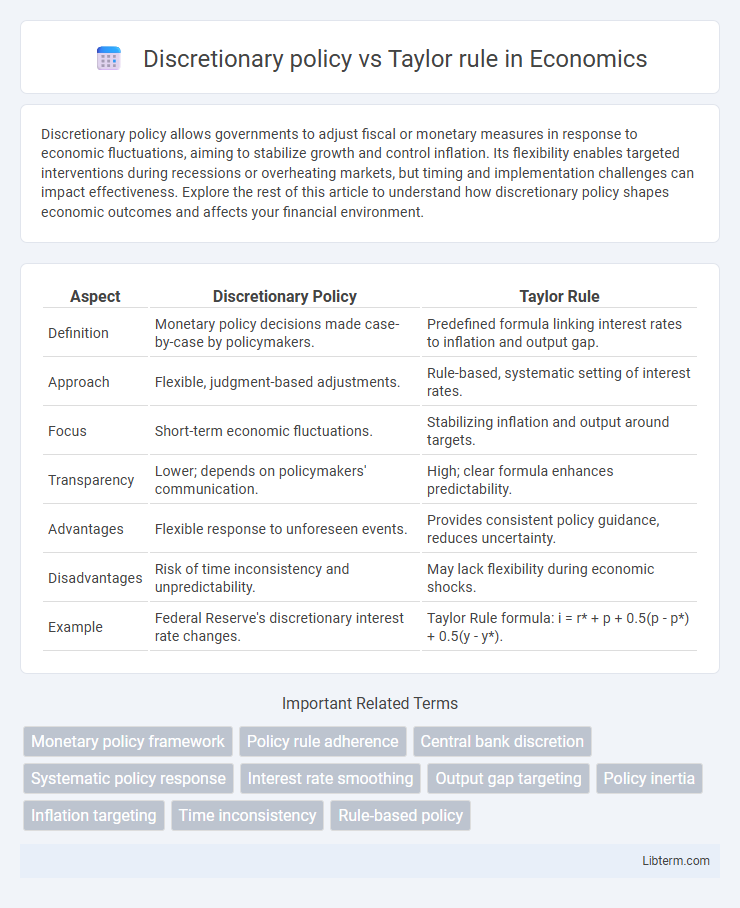Discretionary policy allows governments to adjust fiscal or monetary measures in response to economic fluctuations, aiming to stabilize growth and control inflation. Its flexibility enables targeted interventions during recessions or overheating markets, but timing and implementation challenges can impact effectiveness. Explore the rest of this article to understand how discretionary policy shapes economic outcomes and affects your financial environment.
Table of Comparison
| Aspect | Discretionary Policy | Taylor Rule |
|---|---|---|
| Definition | Monetary policy decisions made case-by-case by policymakers. | Predefined formula linking interest rates to inflation and output gap. |
| Approach | Flexible, judgment-based adjustments. | Rule-based, systematic setting of interest rates. |
| Focus | Short-term economic fluctuations. | Stabilizing inflation and output around targets. |
| Transparency | Lower; depends on policymakers' communication. | High; clear formula enhances predictability. |
| Advantages | Flexible response to unforeseen events. | Provides consistent policy guidance, reduces uncertainty. |
| Disadvantages | Risk of time inconsistency and unpredictability. | May lack flexibility during economic shocks. |
| Example | Federal Reserve's discretionary interest rate changes. | Taylor Rule formula: i = r* + p + 0.5(p - p*) + 0.5(y - y*). |
Introduction to Monetary Policy Frameworks
Discretionary policy allows central banks to adjust interest rates and money supply reactively based on current economic conditions, offering flexibility to address unexpected shocks. The Taylor rule provides a systematic guideline for setting interest rates based on deviations of inflation and output from their targets, promoting transparency and predictability in monetary policy. Comparing these frameworks highlights the trade-offs between adaptability in discretionary policy and the rule-based rigor of the Taylor rule in achieving stable inflation and output.
Understanding Discretionary Policy
Discretionary policy allows policymakers to make decisions based on current economic conditions without fixed rules, providing flexibility to respond to unforeseen events or shocks. This approach contrasts with the Taylor rule, which prescribes a systematic adjustment of interest rates based on inflation and output gaps. Understanding discretionary policy highlights its ability to address short-term economic fluctuations but also reveals risks of inconsistent actions and time-inconsistency problems.
What Is the Taylor Rule?
The Taylor Rule is a monetary policy guideline that prescribes how central banks should adjust interest rates based on deviations of actual inflation from target inflation and actual GDP from potential GDP. Unlike discretionary policy, which relies on policymakers' judgment and flexibility, the Taylor Rule provides a systematic and rule-based approach to stabilize the economy and control inflation. This rule enhances predictability and transparency in monetary policy decisions by linking rate adjustments directly to key economic indicators.
Key Differences: Discretion vs Taylor Rule
Discretionary policy allows central banks to adjust monetary measures based on current economic conditions and expert judgment, offering flexibility in responding to unexpected shocks. The Taylor rule provides a systematic, formula-driven approach to setting interest rates based on inflation and output gaps, promoting policy predictability and transparency. Unlike discretionary policy, the Taylor rule limits subjective decision-making by anchoring policy adjustments to quantitative economic indicators.
Flexibility and Responsiveness in Policy
Discretionary policy allows central banks greater flexibility to respond quickly to unexpected economic shocks, adjusting interest rates and monetary tools without pre-set constraints. The Taylor rule provides a systematic framework guiding policy based on inflation and output gaps, promoting predictability but potentially limiting responsiveness to sudden changes. While discretionary policy emphasizes adaptability, the Taylor rule enhances transparency and consistency, balancing flexibility with disciplined policy responses.
Predictability and Transparency of Rules
Discretionary policy offers flexibility but often lacks predictability, leading to higher uncertainty in monetary decision-making. The Taylor rule provides a transparent framework by linking interest rate adjustments systematically to inflation and output gaps. This rule-based approach enhances the predictability of policy actions, improving market stability and anchoring inflation expectations.
Economic Outcomes and Stability
Discretionary policy allows central banks flexibility to respond to economic shocks, potentially stabilizing output and inflation but may introduce uncertainty and time inconsistency problems. The Taylor rule provides a systematic framework for setting interest rates based on inflation and output gaps, promoting transparency and predictability in monetary policy. Empirical studies show that adherence to the Taylor rule can enhance economic stability by reducing inflation volatility and output fluctuations compared to purely discretionary approaches.
Historical Case Studies and Applications
Historical case studies reveal that discretionary monetary policy allowed central banks flexibility during economic crises, such as the 2008 financial meltdown, enabling rapid and context-specific interventions. In contrast, the Taylor rule, which prescribes interest rate adjustments based on inflation and output gaps, gained prominence for its systematic approach, demonstrated by its application in the U.S. Federal Reserve's pre-2008 policy framework to anchor expectations and reduce policy uncertainty. Empirical analyses show that while discretionary policy excels in unforeseen shocks, the Taylor rule enhances transparency and consistency in stable economic environments.
Criticisms and Challenges of Each Approach
Discretionary policy faces criticism for its susceptibility to political pressures and time inconsistency, leading to unpredictable monetary outcomes and potential inflationary bias. The Taylor rule, while praised for its systematic framework and transparency, encounters challenges in accurately capturing real-time economic conditions and responding flexibly to unanticipated shocks. Both approaches struggle with balancing responsiveness and predictability, with discretionary policy risking erratic moves and the Taylor rule potentially oversimplifying complex economic dynamics.
Conclusion: Choosing the Right Policy Framework
Discretionary policy offers flexibility to respond to unforeseen economic shocks, allowing central banks to adjust interest rates and money supply based on real-time data. The Taylor rule provides a systematic, rule-based approach that enhances transparency and reduces uncertainty by linking policy decisions to inflation and output gaps. Choosing the right framework depends on balancing the need for adaptive decision-making with the benefits of predictability and credibility in monetary policy.
Discretionary policy Infographic

 libterm.com
libterm.com